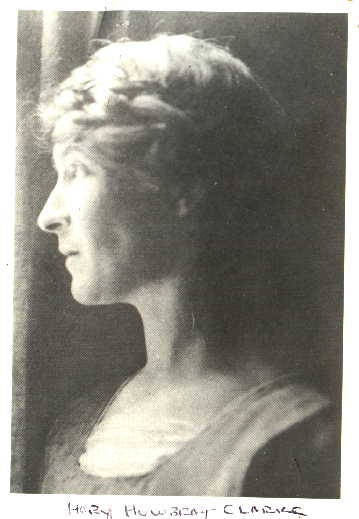

Queer Places:
The Art Students League of New York, 215 W 57th St, New York, NY 10019
The Sunwise
Turn, 2 E 31st St, New York, NY 10016
51 E 44th St, New York, NY 10017
Brocken, Pomona, Rockland County, New York
 Mary
Horgan Mowbray-Clarke (1874 – November 20, 1962) was an American art critic, writer,
publisher, instructor, landscape architect, and the proprietor of The Sunwise
Turn, a hotbed of artistic activity and anarchist political thought in New
York City during the nineteen-teens and twenties. She was also the wife
of John Frederick Mowbray-Clarke, a sculptor who helped organize of the
influential 1913 Armory Show exhibition of modern art.[1][2]
Madge Jenison met sculptor John
Frederick Mowbray-Clarke, at a dinner given by "some liberal group". He
was immediately taken with her, later telling his wife, Mary
Horgan Mowbray-Clarke, that he had been seated between "two of the most
interesting women in America." One was the biographer Katharine
Anthony; the other was Madge Jenison.[2]
Mary
Horgan Mowbray-Clarke (1874 – November 20, 1962) was an American art critic, writer,
publisher, instructor, landscape architect, and the proprietor of The Sunwise
Turn, a hotbed of artistic activity and anarchist political thought in New
York City during the nineteen-teens and twenties. She was also the wife
of John Frederick Mowbray-Clarke, a sculptor who helped organize of the
influential 1913 Armory Show exhibition of modern art.[1][2]
Madge Jenison met sculptor John
Frederick Mowbray-Clarke, at a dinner given by "some liberal group". He
was immediately taken with her, later telling his wife, Mary
Horgan Mowbray-Clarke, that he had been seated between "two of the most
interesting women in America." One was the biographer Katharine
Anthony; the other was Madge Jenison.[2]


Mowbray-Clarke was born in Nyack, New York in 1874. She came from a large working-class Irish Catholic family, her father a landscape architect, gardener, and later grocery store owner. Her brother Stephen, born in 1854, was the inventor of the half-tone printing process, which enabled the printing of photographs in newspapers. She attended the Art Students League of New York as a girl of 16. Mary was one of the few female alumnae of the League to have found work as a professional illustrator, drawing battleships for the Boston Herald during the Spanish-American War. It was at the Art Students League that she met Arthur B. Davies in 1888; the two became romantically involved, and Davies introduced her to a number of art world notables.[3] She met Jamaican-born British sculptor John Mowbray-Clarke while teaching art at the Finch School on the Upper East Side in 1904. In 1907 she published her first book, The Argonaut art history.[4] Mowbray-Clarke and Madge Jenison opened The Sunwise Turn in 1916, on Thirty-first Street just east of Fifth Avenue in New York City. Davies designed the interior, which was "burning orange," while the sign in front was created by the artist Henry Fitch Taylor. In 1919, the shop relocated to 51 East Forty-fourth Street, part of the Yale Club building.[5] The bookshop served as an important intellectual and social center for artists, writers, and revolutionary political thinkers in New York. In addition to selling books, art, textiles, and sculpture, The Sunwise Turn published small editions (including the first edition of The Dance of Siva: Fourteen Indian Essays by Ananda Coomaraswamy, introducing the American public to Indian art and culture, as well as volumes by Witter Bynner, Rainer Maria Rilke, and Lord Edward John Dunsany) and hosted readings and literary events with Robert Frost, Amy Lowell, Lola Ridge, and Alfred Kreymborg. In 1920, a young Peggy Guggenheim went to work as an unpaid assistant in the shop, absorbing Mowbray-Clarke's influence and being first exposed to the avant-garde artists and writers who would come to shape her world as a patron.[6] In 1920 Mary's husband disappeared, eventually returning to England with one of the young students from the Finch School, artist Joanna Mairs. Mary never heard from him again and was left to raise their son Bothwell aka "Bumper" on her own at the Brocken. The bookshop closed for business in 1927, and the corporation was dissolved in 1928.[7][8][9] The Mowbray-Clarkes lived in Rockland County, New York at a farm and studio called Brocken, just six miles from Davies. The name the Brocken is in reference to a local folk-tale about Rosicrucian miners from the Harz mountain range in Germany, of which the Brocken is the highest peak, who had disturbed evil spirits which had been trapped within the High Tor Mountain. Like the Sunwise Turn, Brocken became a social center for exchange of political ideas from socialism to anarchism, and a place for communion between "free spirits."[3][9] In the 1930s and 40s Mary Mowbray-Clarke established herself as a landscape architect, designing the award-winning Dutch Gardens, which still stands in New City, located behind the County Courthouse, as well as a number of gardens found in homes in Rockland County.[10] Mowbray-Clarke died in 1962 in New City, New York. She was survived by her son, John Bothwell Mowbray-Clarke of Bethesda Maryland, and two granddaughters.[1] The archival materials of John and Mary Mowbray-Clarke, and of the Sunwise Turn Bookshop are held by the Harry Ransom Center at the University of Texas at Austin[11] and in the Archives of American Art, Smithsonian Institution in Washington, D.C.[12]
My published books: